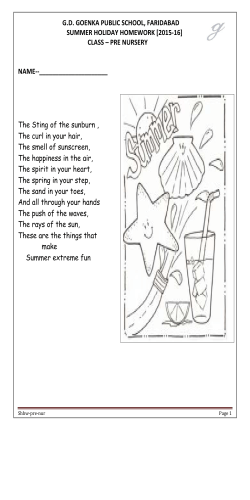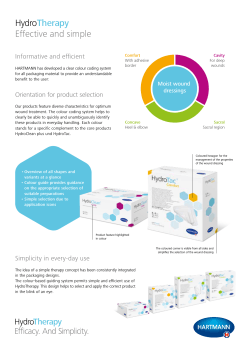
Samples
An abstract submitted for poster presentation in the 32nd IGC, Interlaken, Switzerland, 13-17 July 2011 Bastnäsite from Pakistan coloured by Rare Earth Elements (REE), exhibiting a colour-change Franz Herzog , Michael S. Krzemnicki SSEF Swiss Gemmological Institute, Basel, Switzerland, [email protected] Objectives of study - role of REE for colour and colour change behaviour - colorimetry for dichroism and colourchange behaviour - detailed chemical composition of samples - allocation of REE to spectroscopic features Colour-change from yellowish-green (daylight, left) to brownish-red (incandescent light, right) of Bastnäsite, sample A, 8.824ct. sample Samples - Three Bastnäsite samples (sample 1 – sample 3) were analysed. For comparison reasons a REE-doped glass (sample 4) was included in the study, too. -The transparent Bastnäsite samples 1 and 2 showed a more or less obvious colour-change. Sample 3 showed only a minor colour shift. The colour-change behaviour of the REE-doped glass is similar to the one of the minerals. sample 1 (A) Bastnäsite sample 2 (B) Bastnäsite sample 3 (C) Bastnäsite sample 4 (D) glass weight (ct) 8.828 3.990 SG Methods and procedures - quantify colour perception: dichroism and colour change behaviour - LA-ICP-MS data for samples - spectrometry of the Rare Earth Elements (REE) to link UV-Vis spectra with chemical data - analyse width of absorptivity bands and windows transparency RI RI(o) RI(e) colour in daylight colour in incandescent light origin brownishred Zagi Mountain, Pakistan brownishyellow Pamir (?) brownish brownish Zagi Mountain, Pakistan orangy reddish artificial product 5.12 transparent 1.722 >1.78 greenishyellow 5.07 transparent, somewhat cloudy 1.723 >1.78 greenishyellow 1.174 5.20 transparent 1.709 2.88 transparent 1.722 >1.78 1.552 UV-Vis spectra and colorimetry - UV-Vis spectra taken for all samples (unpolarized), in the range 360nm – 800nm, mode absorptivity, resolution 0.350nm. - CIELab 1976: L*, a*, b* calculated to quantify colour perception of colour / colour-change. Derived quantities: hue and chroma. sample illuminant D65, day-light equiv. CIELab 1976 L* Bastnäsite, A Bastnäsite, B Bastnäsite, C glass, D 43.38 39.38 32.77 54.50 a* 17.36 12.45 25.65 14.86 b* 63.24 52.06 60.60 11.16 hab 74.65 76.55 67.06 36.91 illuminant A, incandescent light equiv. CIELab 1976 Cab 65.58 53.52 65.80 18.59 L* 46.91 42.23 36.96 56.71 a* 27.56 22.46 32.91 23.35 b* 62.77 51.64 62.84 17.36 hab 66.29 66.49 62.36 36.62 Cab 68.55 56.31 70.93 29.09 Chemistry: LA-ICP-MS data - data measured at the University of Bern. - system: pulsed 193 nm ArF Excimer laser with an energy-homogenized beam profile coupled with an ELAN DRC-e quadrupole mass spectrometer. - standard: NIST 610 - data analysis performed with SILLS - in the table aside only the REE-oxides (plus ThO2) are given. - transition element concentrations where below detection limit. Conclusions The results gotten so far, plus some spectroscopic considerations, lead to: - The colour change behaviour of all the samples is linked to a relatively high concentration of neodymium (Nd) (up to 14% Nd2O3). The important absorption band at ~580 nm can be attributed to this element. - Praseodymium (Pr) is present at a low concentrations (up to 3wt% Pr2O3); its influence is in the range 400 – 500 nm (Dieke et al. 1963) resulting in higher absorptivity in this part of the spectrum. Nd has also a few absorption bands in the same range and thus a clear distinction between absorption due to Pr and Nd is difficult. - The Nd-doped glass sample, containing La and Ce in concentrations 100times lower than in the studied minerals shows a similar colour and colourchange behaviour. Thus, lanthanum(La) and cerium (Ce) do not play an important role for the colour of the Bastnäsites. The behaviour of the Nd-doped glass and the Bastnäsites can be compared, because matrix/coordination effects play a minor role for the well shielded trivalent REE-ions. - The colour-change behaviour of all the samples has been quantified by colorimetric methods, using the CIELab colour-space. The variation in colour-change can be traced to slight differences in the absorption spectra of the samples. Based on our preliminary data, the strength of the transmission window at 480 nm may explain the difference in perception. ! References BERNSTEIN, L.R. (1982): Monazite from North Carolina having the alexandrite effect, American Mineralogist, Vol. 67, pp 356359. DIEKE, G.H. AND CROSSWHITE, H.M. (1963): The spectra of the doubly and triply ionized Rare Earths,Applied Optics, Vol. 2, No.7, pp 675-686 GUILLONG M., MEIER, D. L., ALLAN, M. M., HEINRICH, C. A., and YARDLEY, B. W. D. (2008): SILLS: A MATLAB-based program for the reduction of laser ablation ICP–MS data of homogeneous materials and inclusions.Laser ablation ICP-MS in the Earth Sciences: Current practices and outstanding issues (Sylvester, P., ed).Mineral. Assoc. Can. Short Course Series Volume 40, 328-333. KRZEMNICKI, M.S., HAENNI, H.A., REUSSER, E. (2001): Colour-change garnets from Madagascar:comparison of colorimetric with chemical data, Journal of Gemmology, Vol. 27, pp. 395-408. MASSI, L. (2007): Color-change Bastnäsite-(Ce) from Pakistan, Gems & Gemology, Vol. 43, No. 2, pp. 165-166. NASSAU, K. (2001): The Physics and Chemistry of Color, 2nd. Edition, John Wiley & Sons, ISBN0-471-39106-9 PETTKE, T. (2008): Analytical protocols for element concentration and isotope ratio measurementsin fluid inclusions by LA(MC)-ICP-MS.Laser ablation ICP-MS in the Earth Sciences: Current practices and outstanding issues (Sylvester, P., ed).Mineral. Assoc. Can. Short Course Series Volume 40, 189-218. SCHMETZER, K., BANK, H., GÜBELIN, E. (1980): The alexandrite effect in minerals: chrysoberyl, garnet,corundum, fluorite, Neues Jahrbuch für Mineralogie, Vol. 138, pp. 147-164. SCHMETZER, K., BERNHARDT, H.-J., BOSSHART, G., HAINSCHWANG, T. (2009): Colour-change garnets from Madagascar: variation of chemical, spectroscopic and colorimetric properties, Journal of Gemmology, Vol. 31, pp. 235-282. Acknowledgments Thanks go to G.Bosshart and to Prof. Dr. H.A.Hänni, who both provided samples for the present study. The nice picture, as shown on top of this poster, has been made by Luc Phan of SSEF. Thank you. The LA-ICP-MS measurements were done by Prof. T. Pettke of the University of Bern and he also did review the SILLS-analysis. A great thank you to him as well.
© Copyright 2026









